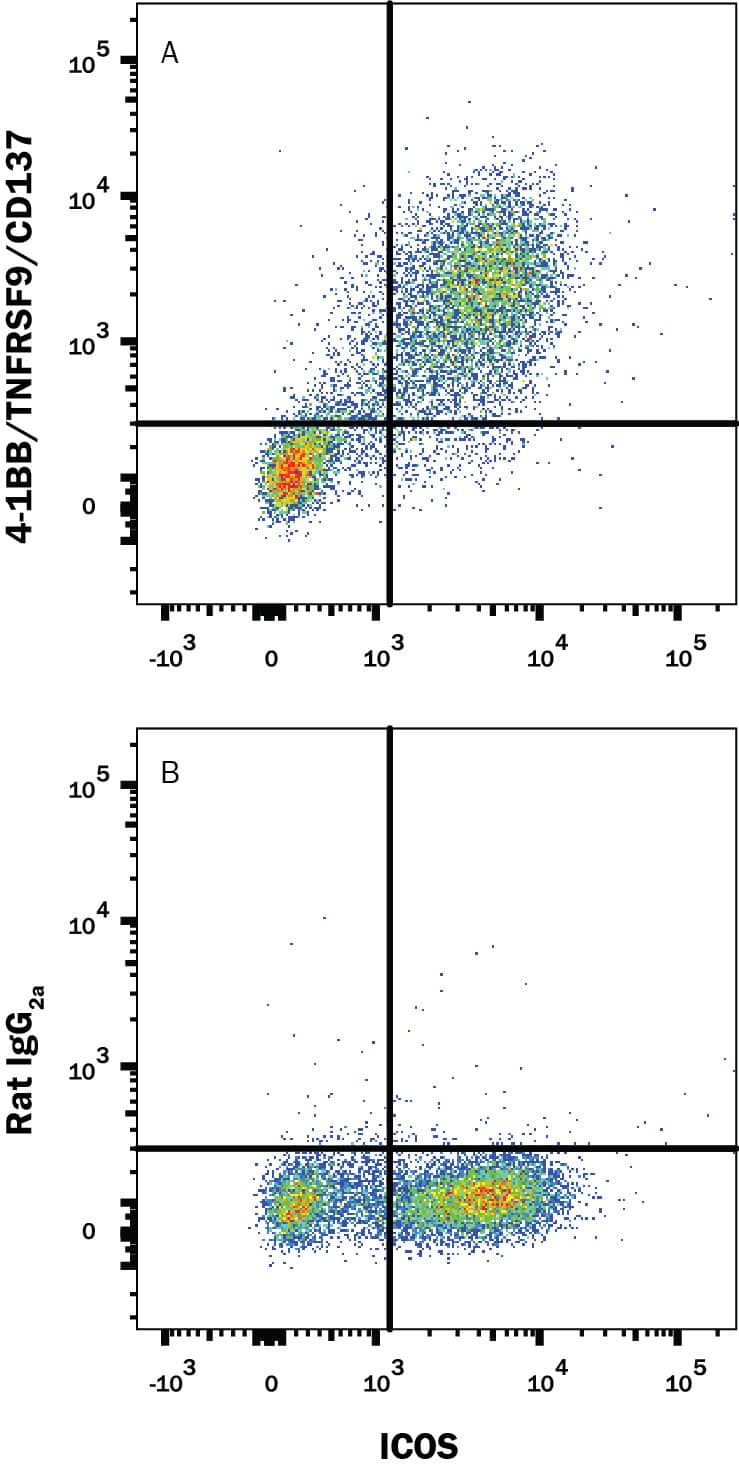Mouse 4-1BB/TNFRSF9/CD137 PE-conjugated Antibody
R&D Systems, part of Bio-Techne | Catalog # FAB937P


Key Product Details
Species Reactivity
Validated:
Cited:
Applications
Validated:
Cited:
Label
Antibody Source
Product Specifications
Immunogen
Val24-Leu187
Accession # P20334
Specificity
Clonality
Host
Isotype
Scientific Data Images for Mouse 4-1BB/TNFRSF9/CD137 PE-conjugated Antibody
Detection of 4‑1BB/TNFRSF9/CD137 in Resting Mouse Splenocytes by Flow Cytometry.
Resting mouse splenocytes were stained with Rat Anti-Mouse ICOS APC-conjugated Monoclonal Antibody (Catalog # FAB168A) and either (A) Rat Anti-Mouse 4-1BB/TNFRSF9/CD137 PE-conjugated Monoclonal Antibody (Catalog # FAB937P) or (B) Rat IgG2APhycoerythrin Isotype Control (Catalog # IC006P). View our protocol for Staining Membrane-associated Proteins.Detection of 4‑1BB/TNFRSF9/CD137 in Activated Mouse Splenocytes by Flow Cytometry.
Activated mouse splenocytes were stained with Rat Anti-Mouse ICOS APC-conjugated Monoclonal Antibody (Catalog # FAB168A) and either (A) Rat Anti-Mouse 4-1BB/TNFRSF9/CD137 PE-conjugated Monoclonal Antibody (Catalog # FAB937P) or (B) Rat IgG2APhycoerythrin Isotype Control (Catalog # IC006P). View our protocol for Staining Membrane-associated Proteins.Applications for Mouse 4-1BB/TNFRSF9/CD137 PE-conjugated Antibody
Flow Cytometry
Sample: Activated and resting mouse splenocytes
Formulation, Preparation, and Storage
Purification
Formulation
Shipping
Stability & Storage
Background: 4-1BB/TNFRSF9/CD137
4-1BB, also known as CD137 and ILA (induced by lymphocyte activation), is a TNF receptor superfamily member and has been designated TNFRSF9. Mouse 4-1BB cDNA encodes a 256 amino acid (aa) residues type I transmembrane protein with a putative 23 aa signal peptide, a 164 aa extracellular domain, a 21 aa transmembrane domain and a 48 aa cytoplasmic region (1-3). A soluble 4-1BB is released from surfaces of cells expressing the transmembrane protein (4). Mouse 4‑1BB shares approximately 60% aa sequence identity with its human counterpart. 4-1BB is expressed on activated CD4+ and CD8+ T cells, thymocytes, and NK cells. It is also expressed on monocytes, neutrophils, DCs and eosinophils (5). The ligand for 4-1BB (4-1BBL), also named TNFSF9, belongs to the TNF ligand superfamily. 4-1BBL is predominantly expressed on activated antigen presenting cells (APCs) such as B cells, macrophages and dendritic cells (DCs). It is also expressed on most T and B lymphoma cell lines. In response to 4-1BBL binding, 4-1BB transduce a T cell co-stimulatory signal in both CD4+ and CD8+ T cells to promote survival and enhance proliferation, cytokine production and effector function. In vivo, the co-stimulatory activity of 4-1BB has been shown to be important in graft-vs-host disease and antiviral CTL responses. On dendritic cells, 4-1BB is a DC-activating molecules that enhances cytokine production and upregulates expression of B7-1 and B7‑2 costimulatory molecules, resulting in an improved ability to stimulate T cell responses (1-5).
References
- Goodwin, R.G. et al. (1993) Eur. J. Immunol. 23:2631.
- Alderson, M.R. et al. (1994) Eur. J. Immunol. 24:2219.
- Kwon, B.S. and S.M. Weissman (1989) Proc. Nat. Acad. Sci. USA 86:1963.
- Wilcox, R.A. et al. (2002) J. Immunol. 168:4262.
- Kwon, B. et al. (2002) TRENDS in Immunology 23:378.
Alternate Names
Gene Symbol
UniProt
Additional 4-1BB/TNFRSF9/CD137 Products
Product Documents for Mouse 4-1BB/TNFRSF9/CD137 PE-conjugated Antibody
Product Specific Notices for Mouse 4-1BB/TNFRSF9/CD137 PE-conjugated Antibody
For research use only
